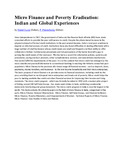| dc.description.abstract | Since independence in 1947, the government of India and the Reserve Bank of India (RBI) have made concerted efforts to provide the poor with access to credit. Despite the phenomenal increase in the physical outreach of formal credit institutions in the past several decades, India's rural poor continue to depend on informal sources of credit. Institutions have also faced difficulties in dealing effectively with a large number of small borrowers whose credit needs are small and frequent and their ability to offer collaterals is limited. Cumbersome procedures and risk perceptions of the banks have left a gap in serving the credit needs of the rural poor. This has led to a search for alternative policies, systems and procedures, saving and loan products, other complementary services, and new delivery mechanisms that would fulfill the requirements of the poor. It is in this context that micro credit has emerged as the most suitable and practical alternative to conventional banking in reaching the hitherto unreached poor population. Micro finance is the provision of a broad range of financial services - such as deposits, loans, payments, money transfers, and insurance - to the low-income households and their micro enterprises. The basic purpose of micro finance is to provide access to financial assistance, including credit to the poor, enabling them to start/expand micro enterprises and break out of poverty. Micro credit helps the poor in making available the credit and other financial services for improving their income and living standards. The micro credit program - which was formally heralded in 1992 with a modest pilot project of linking around 500 Self-help Groups - has made rapid strides in India, exhibiting considerable democratic functioning and group dynamism. The micro credit program in India is now the largest in the world. This book contains 45 scholarly papers in the field of micro finance in India, categorized in five parts: Micro Finance: General Observations . Micro Finance, Self-help Groups, and Financial Inclusion . Micro Finance, Poverty Alleviation, and Empowerment of Women . Technical Aspects of Micro Finance . Micro Finance: Case Studies in India and Abroad. | en_US |

